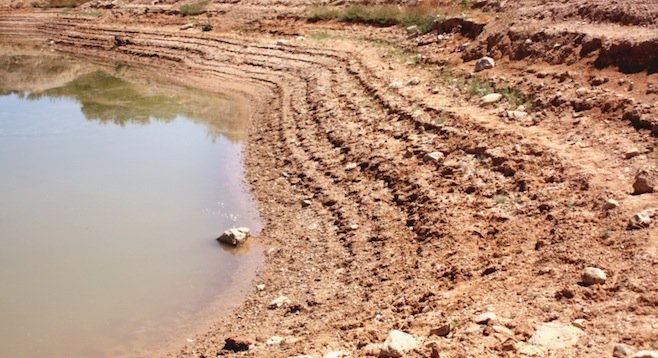 Facebook
Facebook
 X
X
 Instagram
Instagram
 TikTok
TikTok
 Youtube
Youtube

The San Diego City Council's Environment Committee voted Wednesday, October 8, to move San Diego into a "Level 2 Drought Alert" that calls for a 20 percent reduction in water use, up from a 4 percent reduction previously called for under Level 1 conservation efforts. The measure will go before the full council later this month.
"It is clear to me that the current drought is not coming to an end in the near future and it is critical that we take action now in order to guard against more severe restrictions in the future," said committee chair David Alvarez in a release following the vote.
The following restrictions, previously just suggestions, are now mandatory:
Lawns may only be watered three times per week, for no more than seven minutes at a time.
Hoses must have automatic shut-off valves; sprinklers must be on timers.
Vehicles must only be washed before 10 a.m. or after 6 p.m.
Potted plants, gardens, and trees must be watered before 10 a.m. or after 4 p.m.
Plants must not be watered on days that it rains.
Ornamental fountains that don't use recycled water must be shut off.
Water-use enforcement will be based on property type and address. Odd-numbered houses will be allowed to water plants Sundays, Tuesdays, and Thursdays. Even-numbered homes can water Saturday, Monday, and Wednesday. Apartments, condominiums, and business properties will be restricted to watering on Monday, Wednesday, and Friday.
Environmental groups such as San Diego Coastkeeper welcomed the decision.
"Data show mandatory water restrictions are an effective measure to conserve water. Coupled with the City’s progress on wastewater recycling, our water supply future begins to look brighter," said Coastkeeper representative Matt O'Malley, who also echoed the sentiments of councilmember Marti Emerald in suggesting that such conservation measures should become the "new normal" for San Diego.
Governor Jerry Brown had already called a statewide drought alert in January, pushing Californians to reduce water use by 20 percent — use rates have declined by only about 11.5 percent since then.
Meanwhile, effects of the drought, now in its fourth year, are beginning to show up in ways beyond the needed conservation efforts. According to the energy-focused website oilprice.com, short water supply is now threatening the state's green-energy goals.
During the first six months of the year, California typically generates about 20 percent of the state's electricity from hydroelectric power plants. In 2014, however, reduced water flow cut that rate to 10 percent. While some of the slack has been picked up by increased reliance on solar and wind (which recently surpassed hydroelectric as the number-one renewable energy source in the state), reliance on natural-gas-fired plants was up 16 percent to make up for the hydroelectric shortage.


The San Diego City Council's Environment Committee voted Wednesday, October 8, to move San Diego into a "Level 2 Drought Alert" that calls for a 20 percent reduction in water use, up from a 4 percent reduction previously called for under Level 1 conservation efforts. The measure will go before the full council later this month.
"It is clear to me that the current drought is not coming to an end in the near future and it is critical that we take action now in order to guard against more severe restrictions in the future," said committee chair David Alvarez in a release following the vote.
The following restrictions, previously just suggestions, are now mandatory:
Lawns may only be watered three times per week, for no more than seven minutes at a time.
Hoses must have automatic shut-off valves; sprinklers must be on timers.
Vehicles must only be washed before 10 a.m. or after 6 p.m.
Potted plants, gardens, and trees must be watered before 10 a.m. or after 4 p.m.
Plants must not be watered on days that it rains.
Ornamental fountains that don't use recycled water must be shut off.
Water-use enforcement will be based on property type and address. Odd-numbered houses will be allowed to water plants Sundays, Tuesdays, and Thursdays. Even-numbered homes can water Saturday, Monday, and Wednesday. Apartments, condominiums, and business properties will be restricted to watering on Monday, Wednesday, and Friday.
Environmental groups such as San Diego Coastkeeper welcomed the decision.
"Data show mandatory water restrictions are an effective measure to conserve water. Coupled with the City’s progress on wastewater recycling, our water supply future begins to look brighter," said Coastkeeper representative Matt O'Malley, who also echoed the sentiments of councilmember Marti Emerald in suggesting that such conservation measures should become the "new normal" for San Diego.
Governor Jerry Brown had already called a statewide drought alert in January, pushing Californians to reduce water use by 20 percent — use rates have declined by only about 11.5 percent since then.
Meanwhile, effects of the drought, now in its fourth year, are beginning to show up in ways beyond the needed conservation efforts. According to the energy-focused website oilprice.com, short water supply is now threatening the state's green-energy goals.
During the first six months of the year, California typically generates about 20 percent of the state's electricity from hydroelectric power plants. In 2014, however, reduced water flow cut that rate to 10 percent. While some of the slack has been picked up by increased reliance on solar and wind (which recently surpassed hydroelectric as the number-one renewable energy source in the state), reliance on natural-gas-fired plants was up 16 percent to make up for the hydroelectric shortage.
Comments